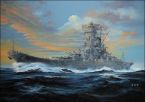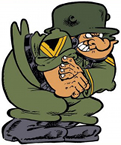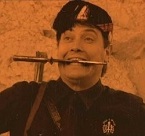beppi
Posts: 382
Joined: 3/11/2004
From: Austria
Status: offline

|
quote:
ORIGINAL: Nemo121
GJ,
No, the new exe your game and mine is using helps tremendously in the fighter vs fighter round but it appears that as we've looked deeper we've uncovered a hard limit on the number of firing passes vs bombers. Basically whether you have 100 fighters on CAP or 2,000 you only get 200 firing passes vs bombers.
What this means for your CV TFs is that if you have 2,000 fighters on CAP and 800 unescorted bombers come in to attack you may well shoot down 200 of them ( assuming each firing pass results in a kill ) but the other 600 will be unintercepted because of the hard limit on firing passes. Those 600 bombers will then proceed to attack your CVs without being intercepted or fired upon by fighters. This explains why a lot of late-war scenarios were seeing devastating attacks on USN CV TFs in which large Japanese raids would continually "get through" no matter how much CAP the Allies had in the air.
Basically it is a simple numbers game. If Japan sends 800 planes to attack without any escort 600 of them are GUARANTEED to break through CAP and attack US shipping. That's simply the way the code works. This is why ( in your game and others ) when rader ( or others ) have attacked in large numbers so many of the planes have gotten through ( I'm sure you can think back to a few attacks where you had huge CAP but the bombers still got through --- that was probably in large part due to this hard limit on firing passes ).
I think the game has improved hugely over time and recently but sometimes this is the way things work.... As time passes and you fix one thing you actually uncover something else. That's not an attack on the game or anything, its just part of the process of iterating it to make it better with each iteration.
The reason Da Babes etc aren't seeing the problem is that most of their games appear to be early to mid-war games where you just don't see these large attacks. Your game and mine are late-war games in which masses kamikaze and massed normal strike group attacks are the norm and so that's why we've uncovered this. A few other late-war games ( based on postings here and elsewhere ) have also noted the problem but until now didn't know the reason why.
At present, for Japan, this changes the way you should play the late-war game. At present it totally makes sense for Japan to save up bombers and strike aircraft in order to launch massive raids over a single day such that they flood the defensive CAP with more than 200 strike craft. By doing that a large portion of bombers will always get through and it only takes 4 or 5 bad days for the USN CV TFs for them to be halved in number. For Japan giving the USN 4 or 5 bad days in 1944 is an eminently achievable goal (IMO of course ).
beppi,
I'm not sure we need a player switch because that would be open to conflict where one player might think switching to the new model was valid at a given time and the other wouldn't. I could foresee lots of disagreement. I think that, perhaps, all we need to do is scale the number of firing passes vs bombers based on the number of fighters intercepting.
What do I mean by that?
1. If you have 200 escorts and 200 bombers and 400 CAP fighters then the game would see a 1:1 ratio and use the current hard CAP of 200 firing passes on the assumption that 200 CAP fighters would tangle with 200 escorts and 200 would go for the bombers.
2. If you have 200 escorts and 200 bombers vs 800 CAP fighters then the game would assign 200 CAP fighters to tangle with the escorts and send 600 vs the bombers - yielding 600 firing passes.
Obviously those figures are just pulled out of the air but it shows how a system which compares CAP fighters to escorts + bombers could easily enough yield some sort of dynamic sliding scale where more CAP yields more firing passes.
I'm sure someone else can come up with a far better model though. I'm just using that to show how a dynamic model could be iterated towards.
Of course if anyone thinks a 200 firing pass hard limit is historically defensible then they should feel free to pipe up. It is important to consider all sides.
Actually if i understood right the posting of michaelm it is not "that" harsh as you describe it.
Currently you have 200 firing passes. For each firing pass a group 1-8 planes fights another group of 1-8 planes. (michaelm described it as a maximum of 8 planes). So theoretical 1600 planes on each side (3200 total) can engage with the 200 firing passes BUT. this is the theoretic maximum. The problem for me is that a pass with 8 vs 8 planes does not kill or damage all 8 planes on each side. Usually 1 or maybe 2 planes get shot down, maybe another gets damaged or runs out of ammo.
And here it gets "problematic". Cause if you have a 700 planes strike against a 1400 defender cap it wil be impossible to completly defend against the strike. If you count 50% of the CAP are not out of position that are 700 planes. If you then say you have a warning time of 60 minutes each CAP plane should do much more than one firing pass. So if you say a pass takes 10 minutes each plane should be able to do 6 passes.
This would lead to a 700 * 6 to 4200 attacks. If you now count the optimum of 8 planes each pass you would need 525 passes to correctly fight the battle.
If you have 200 passes there can be 200 to 1600 engagements. If you say each plane can engage 6 times (just lets assume it) the CAP can handle 25 (worst, each group only has one plane) to 200 planes (optimum, each group has 8 planes always) on each side.
If you have 300 passes there can be 300 to 2400 engagements. So again the theoretic minum are only 37,5 planes for each side. The maxmimum here again are 300 planes for each side if you assume there should be 6 attacks. If you say that you just want 1 attack you can have from 300 to 2400 planes for each side. But 1 attack is not enough to bring down good numbers of attacker planes.
So i belive to understand the problem the devs tried to avoid. I do no think the "aspect" time is really possible during the calculations. So to limit each group from firing too often they used a hard cap which allows an maybe accurate simulation for small fights and scales to a limit. I understand that if you would just remove the cap each plan would fight each other until all planes are either damaged/destroyed/out of fuel/ammo.
So even small scale combat would lead to each sides pounding each in a quite ahistoric way. And i think that is the problem of the BigBabes players and that was the reason to ask for a switch. Basically you would need a "dynamic" rule depending on the size of the defender and even (for sweep) depending on the attacker size. I do not think that the problem is as easy to solve as someone might think. If you extend the firing passes to much you trash the early war small scale fights, if you keep it to low you screw the late war big attack hits big CAP scenarios.
Just to describe the effect:
Lest assume you have 160 attacker planes and 160 defender planes. We group the planes together in groups of 4 planes (the average between 1 and 8). And we have 200 firing passes. We assume each pass kills 0,1 planes, damages 0,2 planes and 0,1 plane drops out of combat. So we lose 0,5 planes each firing pass.
So we have 40(40 on each side, but always a group battles a group) groups, each group has 5 passes. So with a drop out rate of 0,5 planes each pass after the 5 passes we have 2,5 planes disabled and 1,5 planes each group are still ok. They fly home. Now if you unlimit the passes they fight until all 4 planes in each group are gone on both sides.
No limit basically (from my understanding) means that a fight goes on until all planes on one side are either destroyed or returned home for a reason. Even if that would take a very big amount of combat rounds. Again if you assume a round takes 10 minutes then you could have a fight which goes on for massive amounts of time.
Actually right now it is exactly the way for small scale combat. They fight until no fighting is possible as they will never run out of firing passes.
< Message edited by beppi -- 1/25/2012 12:25:25 AM >
|
 Printable Version
Printable Version

 So the number of fighters should be the basis, not a hardcoded number of firing passes because no matter how that hardcoded number looks like, it would near always be wrong.
So the number of fighters should be the basis, not a hardcoded number of firing passes because no matter how that hardcoded number looks like, it would near always be wrong.
















 New Messages
New Messages No New Messages
No New Messages Hot Topic w/ New Messages
Hot Topic w/ New Messages Hot Topic w/o New Messages
Hot Topic w/o New Messages Locked w/ New Messages
Locked w/ New Messages Locked w/o New Messages
Locked w/o New Messages Post New Thread
Post New Thread